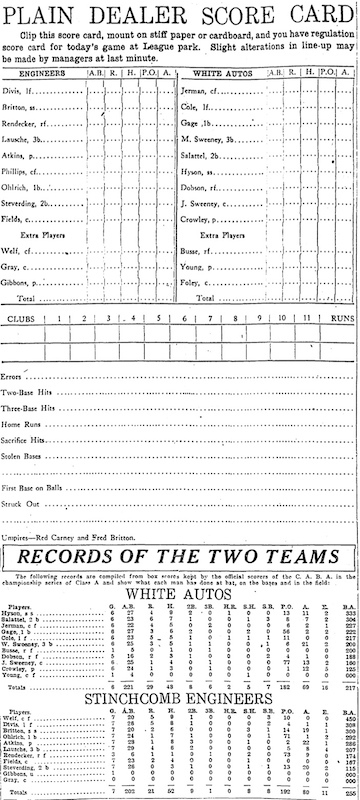National Amateur Baseball Association Tournament

On October 10, 1915, the natural amphitheater at what is now Cleveland Metroparks Brookside Reservation hosted possibly the largest crowd to ever assemble for an amateur sporting event. Attendance of the baseball game was estimated at between 80,000 and 115,000 by newspapers, park staff and city officials. The game would be remembered as the pinnacle of the sport's popularity in Cleveland. While amateur baseball continued to attract huge audiences until the 1950s, the matches held during the National Amateur Baseball Association tournaments of 1914 and 1915 proved to be the most memorable. Captured in film and panoramic photographs, Clevelanders would harken back to these games as the heyday of the amateur sport. The successes and complications that arose from the series of matches, though, provided a point of departure for the National Amateur Baseball Federation to be born and develop a lasting amateur baseball circuit in the Midwest.
The match on October 10 was representative of everything amateur baseball could be: The White Autos of Cleveland were down three runs at the end the third inning. Pitcher Big Six Louis Crowley struggled against the Luxus, Omaha's championship team. The game turned at the bottom of the fourth inning. The Autos rallied with seven hits, three errors, two hit baseman and a sacrifice for a total of eight runs. The screams and cheers of the crowd amassed into a deafening roar that contributed to the chaos of the inning; the visiting team threw wildly and missed easy fly balls. The noise continued to stilt conversations and drown out a brass band performing for the occasion. Unable to recover, the Luxus lost by a score of 11 to 6. As soon as the umpire called the final out and the championship was secured, a crowd swarmed the field. Crowley was lifted on their shoulder, and impromptu versions of "The Star Spangled Banner" and "Hail, Hail, the Gang's all Here" were sung. A procession of trucks loaded with rooters and the band led the victorious White Autos down West 25th Street to the viaduct, and eventually to the Hollenden on Public Square. Once the festivities waned, the trucks drove the players back to East 79th Street- where the amateur team lived and worked at their sponsor's auto factory. The White Autos went on to win the national championship in San Francisco.
The attendance of the game was astounding, and the event was quickly proclaimed to be the largest amateur baseball crowd to ever assemble. This defining match, however, almost never took place. The White Autos had already been eliminated from the 1915 tournament by a team from Johnstown, Pennsylvania. Initially scheduled for three games, the president of NABA ordered the series cut to a single match the night before the contest. Backers from the club disregarded this ruling to give fans in each city a chance to see the teams play. Johnstown won the first game, and Cleveland the remaining two. NABA, however, only recognized the first match. Up to that point, the number of games in a series was decided on by the clubs. Because the tournament schedule had no set dates, NABA proved ineffective in managing multiple coinciding intercity series. Cleveland's division had fallen behind due to multiple extended series. The White Auto's loss against Johnstown was further marred by a dispute over the officiating; Johnstown's victory was gained through an umpire's call that ran contrary to major league rules. NABA conceded that the short notice provided for the abbreviated series was unfair, and ordered that the first game be played over to rectify the disputed call. Having lost two of the three games, Johnstowns forfeited the rematch and allowed Cleveland to move forward in the tournament.
Other Cleveland matches were disputed, further raising questions about the fairness and organization of the tournament. The Omaha Luxus filed a complaint against the White Autos for adding players to its roster. Since NABA failed to put in place a player limit for teams, an intercity series between Detroit and Cleveland found the latter club with two less members. An agreement was made between the teams that Cleveland could increase its roster by two persons in order that both clubs would have 15 players. Omaha's claim suggested that this practice resulted in teams being padded with elite players from their region, and claimed that only the original team should be permitted to play. At the root of this controversy was a gap in the National Amateur Baseball Associations' rules for taking into account the various conditions of amateur systems in different cities. In place of set tournament rules from NABA, the tournament matches were held under a series of agreements between competing clubs.
The list of problems and inefficiencies that arose from these informal agreements was long. Amateur systems represented in the tournament used both American and National league rules, often dependent on their city's major league affiliation. Procedures to assign skilled and fair umpires were lacking. Player limits did not exist. Dates for beginning the intercity competitions varied. Semi-professional players were brought onto amateur teams. No methods were defined to raise funds to pay visiting teams or reimburse the expenses of injured players. These issues provided the groundwork from which the National Baseball Federation was built. The ambitious tournament system was young, and would be refined by the Federation. The National Amateur Baseball Association as it existed would not stand the test of time, and merged with the National Baseball Federation 1919. While relics and public memory of the games suggest that the record-setting attendance signaled the pinnacle of the amateur sport's popularity in places such as Cleveland, the tournament more notably led to the creation of the National Amateur Baseball Federation- which is now the oldest continually functioning baseball organization in the United States.
Images







